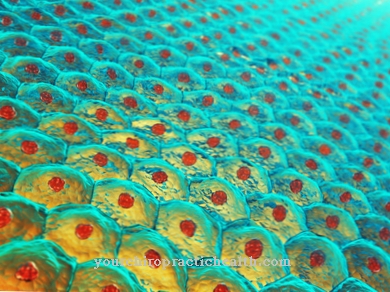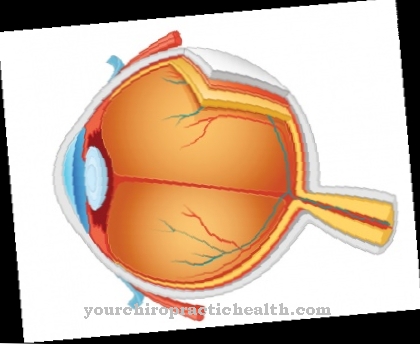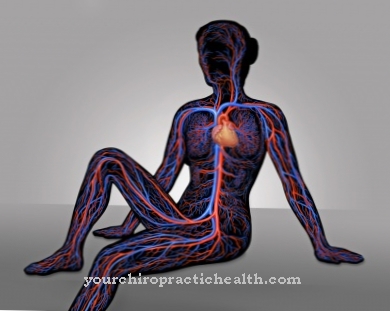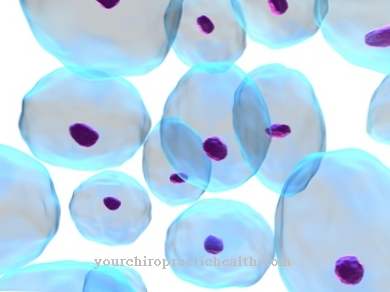A Polymerization characterizes the formation of polymers from monomers. There are different types of polymerizations in chemistry and biology. Polymerization reactions take place in the body to form biopolymers such as proteins, nucleic acids or polysaccharides.
What is the polymerization?

Polymerization is a collective term for the formation of polymers from low molecular weight monomers. Polymerization reactions play a major role in both chemistry and biology. Polymers are high-molecular substances that consist of certain basic building blocks. These basic building blocks, also called monomers, assemble during the polymerization and form high-molecular chains.
Polymers can be composed of both the same and different monomers. In chemistry, for example, polyesters, polyethylene, polyvinyl chloride (PVC) or other plastics are known as polymers. In biology, proteins, nucleic acids or polysaccharides are highly complex biopolymers.
There are different types of polymerization reactions in the chemical field. A distinction is made between chain growth and step growth reactions. In the chain growth reactions, further monomers continuously bind to the activated chain after a start reaction. This then leads to chain growth. In the step growth reactions, the monomers involved must have at least two functional groups. There is no constant chain growth, rather dimers, trimers or oligomers are initially formed, which later combine to form a longer chain. Typical step growth reactions take the form of addition or condensation reactions.
However, the formation of biopolymers in biological systems is far more complicated. It requires many different reaction steps. The formation of proteins or nucleic acids takes place, among other things, only with the help of templates. The sequence of the nitrogen bases in the nucleic acids is determined in the genetic code. These in turn encode the sequence of the amino acids in the individual proteins.
Function & task
Polymerizations play an important role in all biological systems of bacteria, fungi, plants and animals (including humans). Proteins and nucleic acids are the prerequisites for life in general. At its core, the polymerization reactions for the formation of these biomolecules and their breakdown are the actual reactions of life.
Nucleic acids are components of DNA and RNA. They consist of phosphoric acid, a monosugar (deoxyribose or ribose) and four nitrogen bases. Phosphoric acid, sugar and a nitrogen base are each composed of a nucleotide. The nucleic acids in turn consist of chains of nucleotides in a row.
Deoxyribose is built into DNA and ribose is built into RNA as a sugar molecule. The only difference between the individual nucleotides is the nitrogen base.Three consecutive nucleotides each encode one amino acid as a triplet. The sequence of the nucleotides represents the genetic code.
The genetic code defined in the DNA is transferred to the RNA via complex mechanisms. The RNA is then in turn responsible for the synthesis of proteins with a fixed amino acid sequence. Certain sections of the DNA (genes) encode the corresponding proteins.
Every protein has a special function in the organism. There are muscle proteins, connective tissue proteins, immunoglobulins, peptide hormones or enzymes. A special enzyme with a specific composition is responsible for each metabolic step. This already shows how important precisely coordinated polymerisation reactions are for building nucleic acids and proteins for smooth biochemical processes in the organism.
For example, the enzymes must have the correct amino acid sequence in order to be able to catalyze the specific reaction step in the metabolism for which they are responsible.
In addition to proteins and nucleic acids, polysaccharides are also important biopolymers in the organism. In plants, they often have supportive functions. They also store energy. The starch in the potato is a reserve substance that it uses to generate energy during germination. Humans also store glycogen in their liver and muscles to cover their energy needs when they are not eating or during intense physical activity. Like starch, glycogen is a polymer and is made from the monomer glucose.
Illnesses & ailments
Disturbances in the context of biological polymerisation reactions can lead to considerable health problems. As already mentioned, nucleic acids are important biopolymers. If the sequence of certain nitrogen bases changes due to chemical processes, there is a so-called mutation. The mutated gene continues to encode proteins, but their amino acid sequence changes. The proteins modified in this way can no longer properly fulfill their function in the affected cells.
This can lead to metabolic diseases, as an enzyme may fail. But maybe the immunoglobulins are also changed. Then immune defects appear. Of course, structural proteins can also be affected by the changes, with many different appearances and complaints.
The mutations are often passed on to the offspring. In the course of life, errors in the reproduction of the genetic code occur again and again. Usually the affected body cells are destroyed by the immune system. However, this does not always work. In some cases, these cells develop into cancer cells and their growth threatens the entire organism.
Many other degenerative diseases such as arteriosclerosis, rheumatic complaints or autoimmune diseases can also be traced back to disorders in the synthesis of biopolymers. Even the synthesis of glycogen, the polysaccharide in the liver and muscles, can fail. For example, there are glycogen storage diseases with abnormally changed glycogen molecules, which in turn can be caused by defective enzymes. The pathological glycogen can no longer be broken down and continues to accumulate in the liver.



























